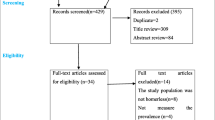Abstract
Suicide is the 10th highest cause of death in the US. Despite the prevalence, little is known about the experiences of people before, during, and after suicidal ideation. A new research tool, the electronic health record, presents an opportunity for behavioral health researchers to obtain objective data across time. The purpose of this study was to explore the usefulness of the electronic health record as a research tool as we seek to better understand the experiences of persons with suicidal ideation. Using the electronic health records, we conducted a retrospective chart review on 66 persons with suicidal ideation in an outpatient behavioral health clinic from September 2015 to January 2017. To be included in this study, participants were required to be adults who demonstrate suicidal ideation evidenced by a score > 0 on the Columbia Suicide Severity Rating Scale. Researchers analyzed participant’s demographics, diagnoses, medication, and frequency and interval of visits to describe participants’ progression of suicidal ideation during the study period. Using the electronic health records, we were successfully able to describe the experiences of persons with suicidal ideation. The natural progression was complex and required close monitoring, medications, and medication changes to identify the optimal medication regimen. Most participants overcame suicidal ideation, but about 40% of individuals failed to follow-up. The electronic health records efficiently and effectively described the experiences of persons with suicidal ideation. However, more research is needed to understand and improve the breadth and depth of their experiences.

Similar content being viewed by others
References
American Society of Health-System Pharmacists. (2016). Escitalopram: MedlinePlus drug information. Retrieved from https://medlineplus.gov/druginfo/meds/a603005.html
Anderson, H. D., Pace, W. D., Brandt, E., Nielsen, R. D., Allen, R. R., Libby, A. M., et al. (2015). Monitoring suicidal patients in primary care using electronic health records. Journal of the American Board of Family Medicine, 28(1), 65–71.
Bruce, M. L., Ten Have, T. R., Reynolds, C. F., Katz, I. I., Schulberg, H. C., Mulsant, B. H., et al. (2004). Reducing suicidal ideation and depressive symptoms in depressed older primary care patients: a randomized controlled trial. JAMA, 291(9), 1081–1091. https://doi.org/10.1001/jama.291.9.1081.
Crosby, A. E., Han, B., Ortega, L. A. G., Parks, S. E., & Gfroerer, J. (2011). Suicidal thoughts and behaviors among adults aged ≥18 years--United States, 2008-2009. Morbidity and Mortality Weekly Report. Surveillance Summaries (Washington, D.C.: 2002), 60(13), 1–22.
Cutcliffe, J. R. (2003). Mental health nursing. Research endeavours into suicide: a need to shift the emphasis. British Journal of Nursing, 12(2), 92–99.
DesRoches, C. M., Campbell, E. G., Vogeli, C., Zheng, J., Rao, S. R., Shields, A. E., et al. (2010). Electronic health records’ limited successes suggest more targeted uses. Health Affairs, 29(4), 639–646.
Griffith, S. D., Thompson, N. R., Rathore, J. S., Jehi, L. E., Tesar, G. E., & Katzan, I. L. (2015). Incorporating patient-reported outcome measures into the electronic health record for research: application using the patient health questionnaire (PHQ-9). Quality of Life Research, 24(2), 295–303.
Ingelse, K. (2016). The Joint Commission sentinel event alert. Detecting and treating suicide ideation in all settings: implications for nursing. Nevada RNformation, 25(3), 12–13.
Kuo, W. H., Gallo, J. J., & Tien, A. Y. (2001). Incidence of suicide ideation and attempts in adults: the 13-year follow-up of a community sample in Baltimore, Maryland. Psychological Medicine, 31(7), 1181–1191.
Nock, M. K., Borges, G., Bromet, E. J., Alonso, J., Angermeyer, M., Beautrais, A., et al. (2008). Cross-national prevalence and risk factors for suicidal ideation, plans and attempts. The British Journal of Psychiatry, 192(2), 98–105. https://doi.org/10.1192/bjp.bp.107.040113.
Posner, K., Brown, G. K., Stanley, B., Brent, D. A., Yershova, K. V., Oquendo, M. A., et al. (2011). The Columbia-suicide severity rating scale: initial validity and internal consistency findings from three multisite studies with adolescents and adults. The American Journal of Psychiatry, 168(12), 1266–1277.
Roy, W., Roaten, K., Downs, D., Khan, F., Pollio, D. E., & North, C. S. (2017). Suicide risk assessment and management: real-world experience and perceptions of emergency medicine physicians. Archives of Suicide Research, 21(3), 365–378. https://doi.org/10.1080/13811118.2016.1199987.
Silverman, J. J., Galanter, M., Jackson-Triche, M., Jacobs, D. G., Lomax, J. W., Riba, M. B., et al. (2015). The American Psychiatric Association practice guidelines for the psychiatric evaluation of adults. The American Journal of Psychiatry, 172(8), 798–802. https://doi.org/10.1176/appi.ajp.2015.1720501.
Steinbrook, R. (2009). Health care and the American Recovery and Reinvestment Act. Perspective, 360(11), 1057–1060. Retrieved from doi:https://doi.org/10.1056/NEJMp0900665.
Tran, T., Luo, W., Phung, D., Harvey, R., Berk, M., Kennedy, R. L., & Venkatesh, S. (2014). Risk stratification using data from electronic medical records better predicts suicide risks than clinician assessment. BMC Psychiatry, 14, 76. https://doi.org/10.1186/1471-244X-14-76.
Turecki, G., & Brent, D. A. (2016). Suicide and suicidal behaviour. The Lancet, 10024, 1227. https://doi.org/10.1016/S0140-6736(15)00234-2.
Viguera, A. C., Milano, N., Laurel, R., Thompson, N. R., Griffith, S. D., Baldessarini, R. J., & Katzan, I. L. (2015). Comparison of electronic screening for suicidal risk with the patient health questionnaire item 9 and the Columbia suicide severity rating scale in an outpatient psychiatric clinic. Psychosomatics, 56(5), 460–469. https://doi.org/10.1016/j.psym.2015.04.005.
Acknowledgements
The authors thank Telisha Bruce for her help in obtaining the data used in this article.
Author information
Authors and Affiliations
Corresponding author
Rights and permissions
About this article
Cite this article
Schwartz, J., Somaiya, M., Cosner, C. et al. Natural History of Suicidal Ideation: Insights from the Electronic Health Record. J. technol. behav. sci. 3, 58–62 (2018). https://doi.org/10.1007/s41347-017-0037-z
Published:
Issue Date:
DOI: https://doi.org/10.1007/s41347-017-0037-z




